As business processes further focus on customer demands in a rapidly changing marketplace, custom CRM (customer relationship management) migration is increasingly essential. However, before jumping into this complex and costly process essential to customer engagement, be aware that proper CRM data migration is critical to ensure data is not lost or damaged.
Consider going on holiday and not labeling your luggage, resulting in your suitcases becoming lost in the system. Formatting and preparing data for your new CRM ensures it reaches its destination safely, and a custom CRM data migration checklist can help you achieve this.
This article will answer essential questions about what happens during a CRM migration. We will also explain the challenges and benefits of transitioning to a custom CRM. Let’s start with a quick overview of the CRM migration process.
What happens during a CRM migration?
CRM data migration involves importing data from a spreadsheet into a CRM system or transferring data from one CRM system to another. This transfer is typically straightforward as long as your data is adequately formatted, and several CRM systems offer tools to streamline the import and export of data.
As every business has unique needs, it is helpful to utilize a custom CRM to ensure user centricity is at the heart of your business processes. However, transitioning to a custom CRM has many challenges, the leading examples of which we will consider next.
Challenges of transitioning to a custom CRM
Despite the necessity of a CRM, there are many challenges in transitioning to a custom CRM data migration process, the first of which involves ownership. Knowing these challenges can help you succeed and avoid wasting time or money.
Ownership challenges
To ensure a smooth migration from the old CRM to the target CRM system, it is vital to define ownership and relationships within your organization. Is it possible for brokers to “own” companies and contacts? Should there be multiple owners or teams? What security should you set up within your CRM data migration process?
Answering these vital questions during the initial discovery phase will help create an optimal user experience within the system.
Data repetition
When multiple records for the same Company/Contact are present in your old database, assigning a team of individuals is essential to determine which needs merging or eliminating. Having a single version of the truth (SVOT) is immensely beneficial, as numerous duplicates lead to disorder and confusion. Moreover, there is no valid reason to have different accounts for one company, so ensure you merge them.
Incomplete data migration
To ensure that the new system is up-to-date, it’s essential to fill in any gaps in the old system. Although it may seem like your data is structured and documented accurately, this is not always the case.
Take time to familiarize yourself with where your company has placed data and its current state. Doing so will enable you to decide which information should be migrated, updated, or eliminated. Don’t underestimate the importance of having a thorough knowledge of your source data. Taking extra time here can help ensure that everything runs smoothly throughout the entire migration process as you transfer all necessary data.
Awareness of these challenges is essential to ensure a successful custom CRM data migration. But despite this process’s challenges, you will see many benefits when you achieve it.
Benefits of migrating to a custom CRM
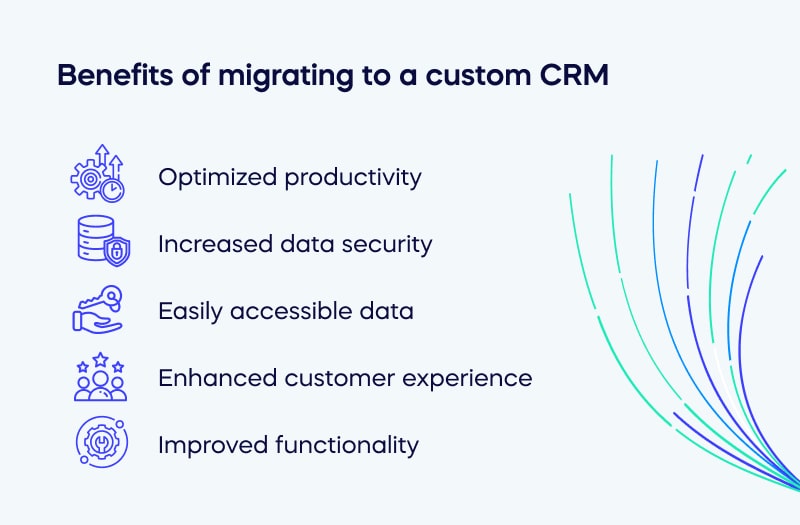
Although you may now understand what CRM data migration is, it might be unclear whether it will benefit your business. Companies choose new systems for many reasons; their current software is underperforming, the tech support inadequate, or maintenance costs too high. With custom CRM migration, these issues can become a thing of the past.
If your current system doesn’t provide effective integration with enterprise tools and is missing essential components, it may be time to consider a switch. There are countless advantages of transitioning to a new CRM solution. Here are a few:
- Optimized productivity
- Increased data security
- Easily accessible data
- Enhanced customer experience
- Improved functionality
In addition, carefully following a CRM migration requirements checklist for implementing new CRM software can improve efficiency, help to lower costs, and achieve a swift ROI. However, a migration strategy is essential to achieving this goal.
Why your migration strategy matters
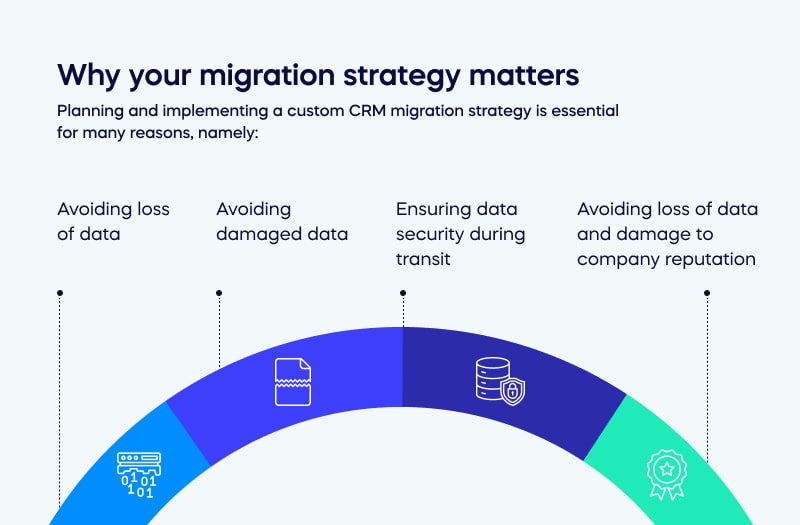
Planning and implementing a custom CRM migration strategy is essential for many reasons, namely:
- Avoiding loss of data
- Avoiding damaged data
- Ensuring data security during transit
- Avoiding loss of data and damage to company reputation
In addition to being aware of the points outlined above, other ways to ensure a successful custom CRM data migration are by being aware of best practices and knowing what to avoid.
Best practices for custom CRM migration
Awareness of best practices and what to avoid while migrating to a custom CRM successfully, safely, and efficiently is essential. The first area to consider is the project scope and the organization of your budget.
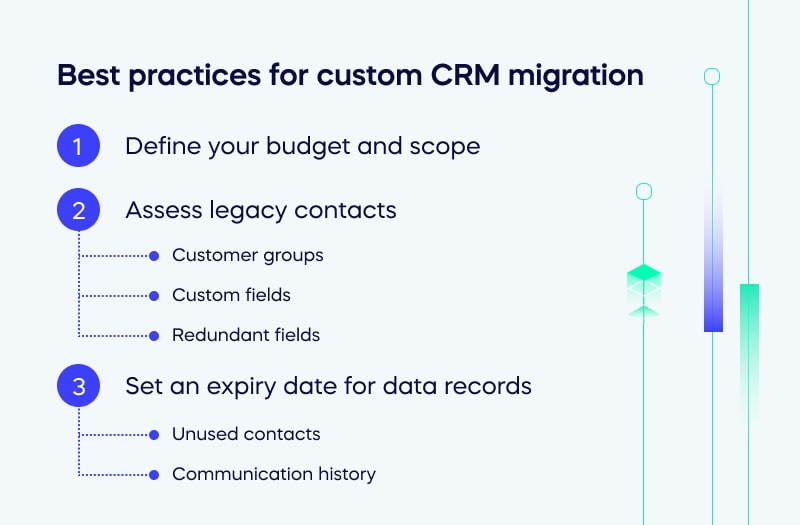
1. Define your budget and scope
Businesses often underestimate the costs and timeline associated with CRM migration. They tend to default to the “better safe than sorry” mentality by migrating their data without considering complexity or cost.
Although this might sound like a good idea initially, it can cost more in additional storage capacity for cloud-based CRMs and other data-related expenses. Sometimes, these hidden charges may exceed the initial cost of buying and implementing your chosen CRM platform. To prevent such an issue from arising, it is best practice to engage in thorough research and uncover any potentially hidden overheads before you start your transition process.
2. Assess legacy contacts
Evaluating all legacy contacts and associated data is essential as you migrate to your new CRM. Remember that clean and organized data is paramount to ensure a successful migration.
Thus, work with key stakeholders to review records for any duplicates, new contact info, or errors they may have noticed. Furthermore, ensure every stakeholder has input on how this contact record can help your business reach its objectives. To maximize your chances of success, consider the following data fields:
- Customer groups: Is it worth the effort to migrate customer groups in your legacy CRM, and are they currently being used? Are there clean industry fields mapped for segmentation contained within this data?
- Custom fields: It’s time to decide which ones to keep for the long term and which ones were created solely for a campaign or short-term goal. Knowing this will help you determine what content needs to remain in your database.
- Redundant fields: Do you have redundant field clusters in your legacy data? Make sure the information is still applicable. It may be tedious now, but it will pay off in the long term.
By completing this process, you will discover what content is imperative to your data migration procedure.
3. Set an expiry date for data records
Examining the data fields for migration is essential, but assessing whether or not all contacts and their related data are still relevant is equally crucial.
Your colleagues from all departments can give essential feedback on this project. Here are some important factors to consider:
- Unused contacts: When is the optimal time to retire a former customer or contact from your system? After how long will it be beneficial to let go of an open lead? Schedule inspections to examine if that data record is still necessary if you’ve had any specific contacts listed in your CRM for more than one year.
- Communication history: Your company needs to track all account and contact engagement levels regarding data privacy management. Doing so includes considering meetings, tasks, emails, phone calls, transactions, web visits, mail merges, and marketing emails so you can make accurate measurements. This process ensures you get the most out of your accounts and contacts while protecting their information.
Every business has unique needs regarding how much historical data they need to retain; however, contacts older than five years are rarely essential. Establishing a cut-off point for contact information is an ideal way of eliminating CRM clutter.
Following on from CRM software migration, it is helpful to examine seven tips for a seamless CRM migration to ensure you streamline your CRM migration process.
7 tips for a seamless custom CRM migration
Follow these seven tips for a seamless custom CRM migration process.
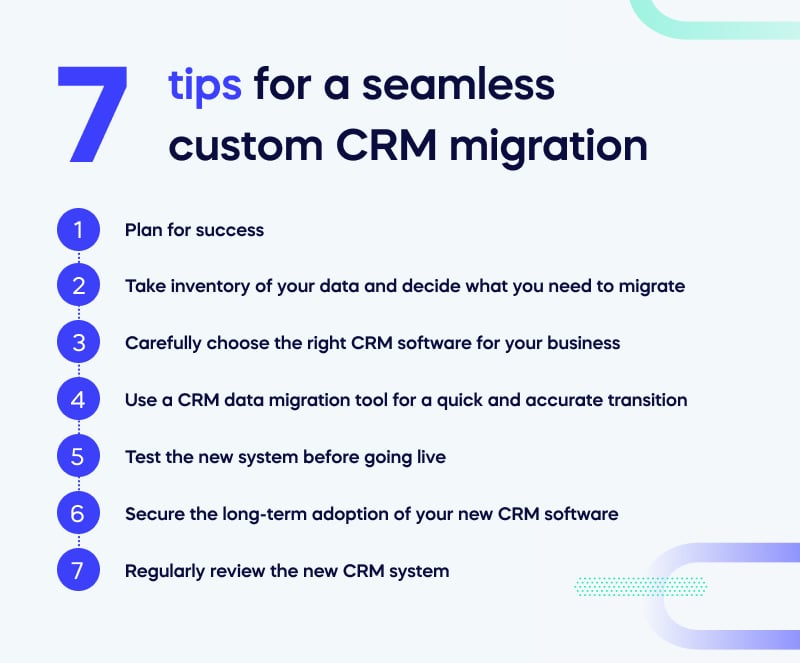
1. Plan for success
Plan for the migration by streamlining your data import and making your migration more straightforward and affordable by evaluating what you need. Ask yourself if it’s necessary to move existing data, such as contacts that have had no interaction with your business in years or email templates from before the rebranding of logos. By cutting back on unnecessary information, you can simplify the entire process.
Before you begin your data migration checklist, take the time to carefully review and categorize the current information to decide what you should include and exclude. Once you have determined this, proceed with cleaning up any defective or obsolete aspects of those relevant files. It’s wise to practice making a backup before carrying out this task in case something essential gets accidentally deleted; if not for peace of mind, then do it as an emergency measure.
The final part of planning is to ensure that the CRM migration aligns with the company strategy. This step is, surprisingly, sometimes skipped. Therefore, ensuring your tech stack serves the needs of your CRM migration to reach organizational goals will grant you a competitive edge.
2. Take inventory of your data and decide what you need to migrate
When transferring your CRM data, don’t forget to take the time to study and map it. Doing so is a crucial element in any CRM migration checklist. Take stock of which data you should shift, why, and what information you can remove from the legacy CRM. Next, consider where this info will reside inside the new system. Group everything properly so users won’t have trouble locating it when needed.
3. Carefully choose the right CRM software for your business
If you feel that choosing CRM data migration tools is daunting, don’t fret. It is easy to find the best tool to make this process easier. Most CRMs have built-in migration capabilities that will transfer your spreadsheet information into the new system in no time. This option usually yields the most effortless and cost-efficient results, so it should be your first consideration when looking for support during this data transition period.
External data migration programs such as Pentaho and Talend Open Studio are available if the essential tools aren’t sufficient. If a more complex situation arises, larger corporations often craft in-house solutions based on CRM API (application programming interface). Yet this step is usually unnecessary if you only intend to transfer a spreadsheet.
4. Use a CRM data migration tool for a quick and accurate transition
After you have examined every conceivable situation that may arise during testing, it’s time for the actual migration. Enable your developers to take their rightful place at the front and center of this critical moment – migrating from an outdated CRM into a fresh one.
5. Test the new system before going live
Before importing your entire dataset into a new CRM, perform a test migration. Select only a smaller set of data and import it; then inspect the results thoroughly for any errors or abnormalities. This strategy allows you to discover issues before they become significant problems in the full-scale migration; if something goes wrong, try deducing what occurred so that you can make adjustments as needed and rerun tests until you achieve successful completion.
6. Secure the long-term adoption of your new CRM software
Ensuring successful adoption of a new technology can be the most challenging component of CRM implementation, regardless of whether the migration is flourishing and whether you’re utilizing a leading platform. Unfortunately, even with all these advancements, your team won’t progress unless they know how the new system works.
To ensure a speedy digital adoption of your new CRM platform, consider using a digital adoption platform (DAP), such as the market-leading offering from WalkMe, to cut the need for live training and improve employee engagement. WalkMe’s DAP saves enterprises time and resources by incorporating training in the flow of work with in-app guidance, self-serve support, automated processes, and streamlined cross-application workflows.
By providing seamless digital experiences for your employees, you can boost employee satisfaction and retention while driving efficiency and productivity.
7. Regularly review the new CRM system
It’s essential to ensure your new CRM system is working efficiently. Review the functionality of the CRM frequently and collect feedback from employees about their experience. Always show that you value their input by regularly communicating data visualizations of their collective feedback. Be clear about actions you take to improve the system as well as optimize their experience and business performance.
Ease the transition with a digital adoption platform
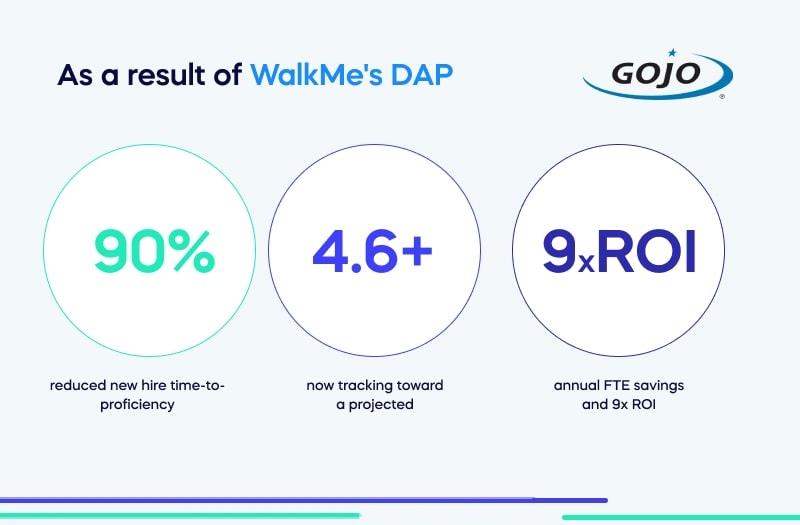
Custom CRM data migration is an essential but delicate and complex process. Companies often need to carry the process out but don’t always consider factors such as data integrity during the migration or how to help employees adapt to new CRM systems.
Companies using a DAP reduce digital friction when transitioning to new custom CRM data migration software. Health and wellness brand GOJO benefitted from WalkMe products during a major time of transition (the Covid-19 pandemic), where Purell hand sanitizer demand shot up, and staff needed to adopt the use of Salesforce Lightning quickly and effectively.
As a result of WalkMe’s DAP, GOJO’s successful CRM data migration reduced new hire time-to-proficiency by 90% and expanded WalkMe to four systems, now tracking toward a projected 4.6+ annual FTE savings and 9x ROI. This case study shows the power of a DAP alongside a custom CRM data migration in supporting business processes to speed up training for a new CRM system, boosting training time, ROI and revenue.


